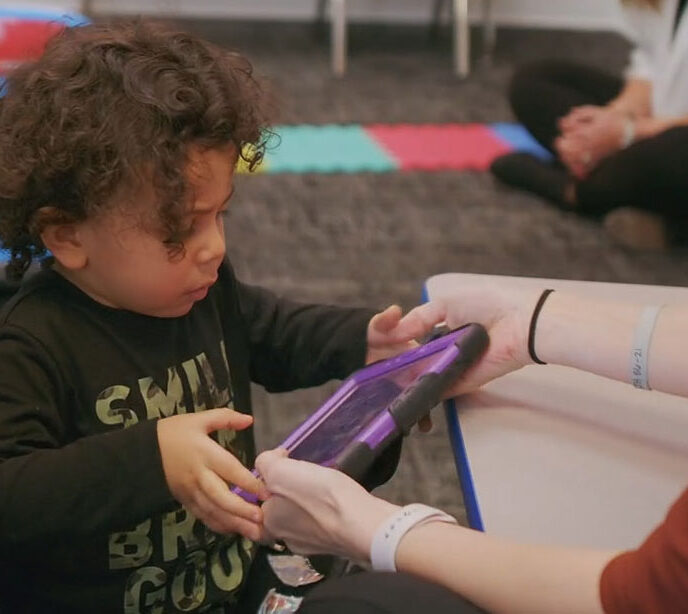What is Stimming In Autism? – Lighthouse Autism Center
Stimming is a self-stimulatory behavior common in autistic children. In this blog, we examine stimming in more detail: what causes it, how to manage it, and why children engage in these repetitive behaviors.
What is Stimming, and Why Does My Autistic Child Stim?

What is stimming?
Stimming, short for self-stimulatory behavior, refers to repetitive actions or movements. Every person stims in some way, whether hair twirling, drumming fingers, or more. Stimming behaviors aren’t always obvious to others, but they are more noticeable in autistic individuals.
Although not restricted to autistic children, self-stim behaviors are one of the most obvious outward signs of autism and are part of the diagnostic criteria. Although stimming isn’t necessarily a bad thing, it can become out of control and cause problems for autistic children.
This blog examines what causes stimming, the types of stimming in autism, managing stimming behaviors, and when you should intervene.
What are the different types of stimming
There are many different types of stimming in autism, and some children may be more inclined toward one form than another. According to WebMD, these are some of the most common types of stimming in autistic children:
- Auditory stimming involves engaging with sounds, such as snapping fingers, repeatedly touching one’s ears, or listening to a specific sound on repeat.
- Vocal stimming includes sounds created with one’s own voice or throat, such as repeated throat clearing, coughing, repeating a word, or humming.
- Tactile stimming encompasses touch-based actions, such as rubbing or scratching the skin, opening and closing fists, tapping fingers on surfaces, or flapping hands and arms.
- Visual stimming refers to behaviors that engage sight, like staring at lights for extended periods, frequent blinking, or eye-rolling.
- Vestibular stimming involves balance or movement, such as pacing or spinning in place.
- Olfactory stimming includes activities related to smell or taste, such as sniffing objects or people or chewing and licking items.
- Full-body stimming involves movements that engage the whole body, like rocking back and forth or spinning around.
Examples of stimming behaviors
In allistic individuals, stimming can look like:
- Fingernail biting
- Hair twirling
- Knuckle biting
- Finger drumming
- Pencil tapping
- Whistling
- Foot tapping
Some of the classic forms of autistic children include:
- Staring at objects — especially anything with lights or movement
- Rocking
- Gazing off into space
- Blinking repeatedly
- Looking out of the corner of their eyes
- Flipping lights on and off repeatedly
- Random humming, shrieking, or making other vocal noises
- Finger snapping, tapping, or putting their hands over their ears
- Tapping on ears or objects
- Covering and uncovering ears
- Tasting or licking — including thumb-sucking, finger-sucking, or tasting something, one wouldn’t normally taste
- Unusual or inappropriate smelling or sniffing
- Repetitive blinking
- Pacing
- Pulling hair
- Pacing or walking on toes
What are repetitive behaviors?
Scientists categorize repetitive behaviors into two groups. So-called “lower-order” repetitive behaviors include hand-flapping, fidgeting with objects, body rocking, and vocalizations such as grunting or repeating certain phrases. “Higher-order” repetitive behaviors include autism traits such as routines and rituals, insistence on sameness, and intense interests.
Repetitive behaviors and stimming in toddlers are among the first signs of autism to emerge in young children. They are seen in people across the autism spectrum. They tend to be more pronounced in those with lower cognitive ability; however, repetitive behaviors have been recognized as part of autism since the condition was first described.
Why do autistic kids stim?
The exact reason for stimming is not entirely known, but many professionals agree that it is a form of self-regulation. Autistic people frequently experience challenges with sensory processing. Based on their specific responses to sensory input, they may either be highly sensitive or show reduced sensitivity to factors like sounds, lights, textures, or smells.
For instance, a child with a hypersensitive reaction to visual stimuli will experience sensory overload with flashing lights. However, a hyposensitive child may not react or even notice them.
In these kinds of sensory experiences, stimming can:
- Diminish overwhelming sensory input for those with heightened sensitivity.
- Offer the required stimulation for individuals with lower sensitivity.
- Assist in managing intense emotions (both positive and negative) that may be hard for an autistic individual to process.
- Provide a means to cope with physical discomfort or pain.
Stimming Triggers
Certain situations and sensory input can trigger stimming in autistic children. Some of the most common stimming triggers include:
- Anxiety and stress
- Joy, happiness and excitement
- Physical discomfort, such as tight shoes or itchy clothing
- Frustration, anger, and unhappiness
- Loud and crowded environments
- Unfamiliar settings or people
- Last-minute change in plans
Should you be concerned or prevent your child from stimming?
Although it can be viewed as disruptive and socially unacceptable, an autistic stim is often very enjoyable for the individual and is a way to reduce stress. If the actions of stimming are deemed safe, they should not be stopped or reduced. There may be times when your child will function better if they are allowed to stim. However, in some instances, stimming can be deemed unsafe.
Can Stimming be Harmful
In some cases, intense or constant repetitive behaviors prevent autistic children from engaging in important activities. Occasionally, they can result in self-harm or harm to others.
Ask yourself the following questions to determine whether your child’s stimming is problematic:
- Is it causing social isolation?
- Is it disrupting your child’s schooling or ability to learn?
- Does it impact other people in your family or your child’s learning environment?
- Is it destructive or dangerous to your child or others?
If you answer “yes” to any of these questions, then intervention may be necessary. However, you should aim to manage stimming and develop alternatives, rather than trying to control it or remove it altogether. You and your child may need support to stop or modify the behavior or reduce their reliance on it.
How to manage stimming
At its core, stimming is a form of self-soothing and communication. It’s important to understand the reasons behind your child’s stimming before you implement management processes.
If your child is engaging in disruptive or dangerous stimming, you can attempt to manage it by:
- Try to eliminate or reduce the trigger.
- Lower their stress and create a calming environment.
- Stick to a routine.
- Encourage better behavior and self-control. Positive reinforcement is always better than punishing behavior.
- Teach an alternative behavior or modified behavior that meets the same needs.
- Teach self-management tools.
- Work with professionals like occupational therapists to learn new coping techniques.
- Get professional assistance through ABA therapy.
Together, we can unlock your child’s potential
Related News

10/07/2025
PECS and Its Use in ABA Therapy – Lighthouse Autism Center
The picture exchange communication system, or PECS, is a teaching system that can help an autistic child or another individual with speech difficulties improve their communication skills. We take a look at PECS’ role in ABA therapy and unpack how it works. What Is the PECS System and How Is It Used In ABA Therapy? […]

08/13/2025
ABA Therapy Tips for Taking Your Autistic Child to the Dentist
Taking Your Autistic Child to the Dentist For any child, and even adults, a trip to the dentist can often be filled with anxiety, fear, and discomfort. For a autistic child, especially, these feelings can be even further heightened by sensitivities to noise, smell, and touch. To make this experience better for both the child […]

08/13/2025
Tips for House Hunting with Your Child on the Spectrum
Guidance for Families with Children with Autism when Moving Moving is always a stressful and complicated endeavor. But when you have a child on the autism spectrum, the thought of packing up your household and moving somewhere new can seem like a near-impossible task. Parents often worry that their children will get overwhelmed by this […]


